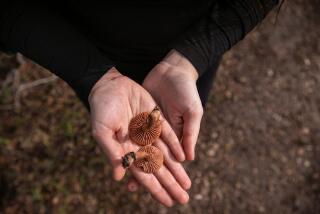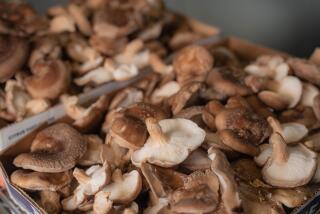For the best berry? Go local. Very local.
- Share via
Growing most fruit is best left to farmers. It’s a science, and they’re better at it. Persian mulberries, also called black mulberries, are an exception to this rule. They are best grown at home, with as short a commute from bough to tongue as possible.
The berries are barely contained juice and, despite their fragility, have persisted as a delicacy only because of the intensity of that juice. The cordial would scarcely exist without mulberries, coulis would merely be an annoying term of menu French, and birds throughout the Mediterranean basin and Britain would have to go on Prozac.
To grow a mulberry, first consider the species: You only want white mulberries (Morus alba) if you plan a silkworm farm. The North American native, the red mulberry (Morus rubra), is an East Coast water-lover with fruit that’s inferior to the black mulberry. What’s worth the water out here is the black mulberry (Morus nigra).
Then consider size. Though often called “shrubs,” mulberries are trees. For small spots, you should plant a miniature. Beautiful weeping miniatures, the soft fruit world’s answer to the tree rose, are perfect for pots.
Once you have your plant, be patient. Nurse it along in a pot and a sheltered spot during impending high summer, then if it’s going into the ground, plant it in the autumn. Select a spot with good drainage and some sun.
According to the Silbers, owners of Papaya Tree Nursery in Granada Hills, Morus nigra’s so tough it can tolerate full California sun. That said, it doesn’t need it. It thrives in southern England and fruits successfully as far north as Sweden. So in a spot with some sun, dig a hole (3 feet across, 2 deep) and amend the soil with one part compost to two parts soil to help drainage, and a generous dollop of manure.
Resist watering the plant before removing it from the pot; then to do that, tilt the plant and slide it from the pot, supporting the bottom. If it’s lifted by the stem, the weight of a wet root ball can and often does tear the roots from the stem and kill the plant.
Planted in autumn, the mulberry will be entering dormancy, so water it into the hole, then water moderately in the lead-up to winter rains. As nettle-like leaves and fruit begin to form next year, water with 20-minute slow drips at least once a week and quick drinks when you’re out with the hose on fiercely hot mornings. It may not bear fruit right away. They say the best fruit comes from mature trees. What is sure is that the most fruit comes from more mature specimens. All the better reason to start now.
Papaya Tree Nursery, 12422 El Oro Way, Granada Hills; (818) 363-3680.






